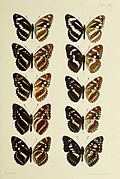| Image | Scientific name | Common name | Distribution |
|---|
 | Limenitis albomaculata Leech, 1891 | | China, N.Sichuan |
| Limenitis amphyssa Ménétriés, 1859 | | Amur, Ussuri, Korea, Central China |
 | Limenitis camilla (Linnaeus, 1764) | (Eurasian) white admiral | southern Britain and much of Europe; Eastern Asia, from Amur River extending as far east as Japan. |
 | Limenitis ciocolatina Poujade, 1885 | | Sichuan, China |
| Limenitis cleophas Oberthür, 1893 | | China |
| Limenitis dubernardi Oberthür, 1903 | | Tibet, China |
 | Limenitis glorifica Fruhstorfer, 1909 | Honshu white admiral | island of Honshu, in Japan |
| Limenitis lepechini Erschoff, 1874 | | Samarkand, Uzbekistan, Tadzhikistan |
| Limenitis moltrechti Kardakov, 1928 | | Amur, Ussuri, Korea, Kyuojo, Kanhoku |
 | Limenitis populi (Linnaeus, 1758) | poplar admiral | widespread in continental Europe and many areas in Asia |
 | Limenitis reducta Staudinger, 1901 | southern white admiral | central and southern Europe (northern Spain, southern and eastern France, Italy, the Balkans, and the Alps),[16] in Western Asia, in Syria, the Caucasus and Iran. |
 | Limenitis sydyi Lederer, 1853 | | Lower Bukhtarma R., E. Kazakhstan; West Altai in Russia; Eastern Transbaikalia, Amur, Ussuri, China, Korea. |
| Limenitis trivena Moore, 1864 | Indian white admiral | tropical and subtropical Asia. |
|













